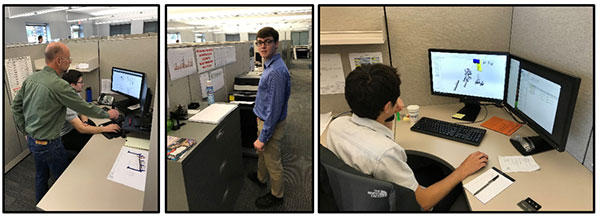![]() Here at the STEELASTIC Company, we are in the business of engineering and manufacturing custom, automated systems that produce tire and heavy equipment track components. To date, we have delivered over 900 of these systems which are operating in more than 55 countries around the globe.
Here at the STEELASTIC Company, we are in the business of engineering and manufacturing custom, automated systems that produce tire and heavy equipment track components. To date, we have delivered over 900 of these systems which are operating in more than 55 countries around the globe.
Our multi-disciplined engineering team’s challenges are broad. In the production pipeline, these include customizing our base technology; in order to produce the customer’s unique components, interface with their downstream process, as well as, conform to their available footprint and other unique localized requirements. Driven by our “big picture” planning process, we additionally face the mission of continually improving, differentiating, and expanding our equipment offerings. Amplifying the difficulty of these challenges is the inherent, non-linear nature of the rubber that our systems process. This material’s property impedes our ability to simulate system performance, upfront in the design process, thus forcing us to rely heavily on the practical experience of our engineers and technicians, as well as, subsequent empirical testing and debugging.
As rubber processing and converting experience is seldom acquired in the classroom and is rarely transferable from other industries, it is imperative for the success of our customers that we fully capture our internal body of knowledge and efficiently pass it on during our on-boarding process.
Our 20-person, multi-disciplined engineering team currently possess an average tenure with STEELASTIC of 7.5 years, with a range of 27 years (longest tenure minus the least). Collectively, we average 13 years of tire and rubber industry experience per engineer and routinely employ two cooperative education students, one of mechanical discipline and one of electrical or software discipline.
Cooperative Education
In the United States, educational institutions use cooperative education programs to afford their engineering students with “real world” experience. These paid, “full-time” positions typically consume 4 to 12 months of the students’ college career.
How We Utilize and Benefit from Collaborative Education at STEELASTIC
Expanding the above discussion, the engineering team at STEELASTIC, typically, employs 2 students per 16-week semester, 3 semesters per year. Often individuals will remain on staff between semesters and return for multiple semesters.
We are open to working with several local institutions, but our primary partnership is with the University of Akron. Candidates are selected based on a combination of academic performance, prior experience on academic or industry design teams, software experience, and oral communication skills exhibited during a phone interview.
Our approach is to initially measure the individual’s aptitudes in our core skill areas, then orientate them to our CAD and ERP systems by working as an assistant to one or more of our staff engineers. This affords the intern the opportunity to acquire and practice new skills, and frees the staff engineer from these tasks, while providing him with the experience to direct and mentor a subordinate which may not otherwise be a part of their current role.

As the intern progresses, we will broaden the tasks put before them. For example, design a component or enclosure on their own versus detail a component or enclosure that was designed by others. Ideally, we task them with a project of their own that can be completed within the time constraints of the semester. Minimally, outside of the daily “grind”, the intern will be afforded several opportunities to attend dedicated technical training and/or trade shows during the semester.
As the semester comes to a close, in addition to conducting a one-on-one evaluation with the intern, we require them to produce a report on their tenure and deliver it to the group in presentation form.
In conclusion, the advantages of cooperative education to the typical engineering student (recently out of a secondary school) are:
- Exposure to a working environment in their field of study, along with the associated experience that they may cite on their resume.
- Enhanced direction in their respective career paths through the ability to “test drive” multiple tracts within their discipline, such as, machine design, panel design, process engineering, software, consumer or industrial products.
- Greatly increase their experience utilizing engineering and business software (CAD, Excel, Rockwell, Siemens, ERP etc.).
- Opportunity to network in a business environment and polish their “non-electronic” interpersonal skills.
- Cash in pocket to temper their academic expenses.
Conversely, the benefits that our business enjoys from cooperative education include:
- An affordable, low risk means to evaluate new talent while bolstering existing capacity.
- Promotion of positive, “word of mouth” discussion about the business within the academic community.
- Means to evaluate management aptitude within our permanent team, as well as, continual refinement of our onboarding process.
- Over time, the process produces a pool of talent that is fully evaluated and onboarded to our business process, thus the individual is able to contribute on day one of permanent employment, which significantly reduces the time and expense of expanding department staff or replenishing positions vacated by advancement.
